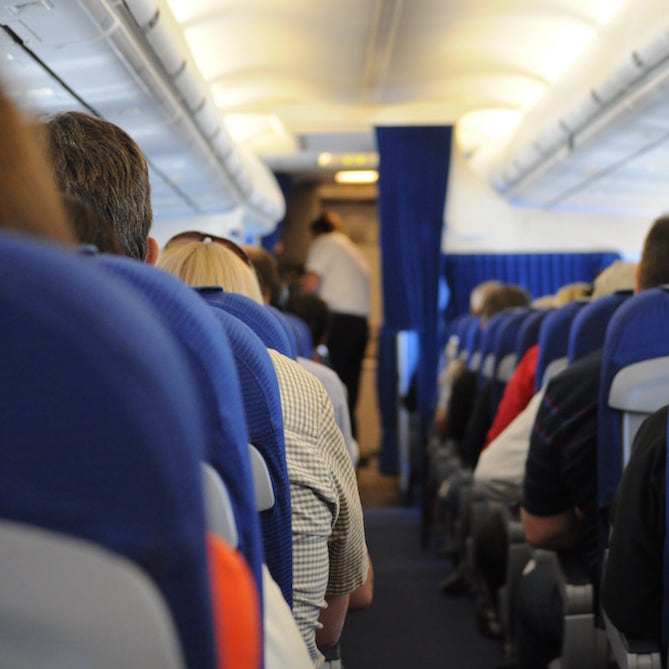
Cello Is My Co-Pilot (Part 1)
Jeffrey Zeigler
Several years back I was flying out of the Dallas-Fort Worth Airport. My cello was strapped into the seat next to me and I was ready to go. Lost in my own thoughts, a flight attendant leaned over and asked me very nicely if I was flying with an oboe. Now, I have flown a great deal with my cello over the years and have conditioned myself to be ready for whatever excuses the flight attendant brings in order to hassle me. But I had never ever heard of a cello being confused with an oboe! In complete shock, my only reaction was a nervous laugh. It was right then that I realized that she was actually quite serious and I immediately apologized. But honestly, where had she thought up that one?
The fact is, every cellist needs to be ready for whatever situation arises when traveling with an instrument. One could easily write a book of the many strategies to adopt. However, I’ll just list a few of my basic rules of thumb.
Rule #1: Know the Rules
In most situations, booking a seat in a bulkhead window seat and strapping the cello in with a seatbelt extension should work just fine. Often however, you will not be able to book the bulkhead when you purchase the ticket. When that occurs, be prepared to spend some time juggling seats around when you get to the airport. Remember, the FAA requires that the cello occupy that seat. So even if the airline or a certain passenger is unwilling to move, somebody will have to be flexible in order to accommodate the cello.
In regard to strapping the instrument in, I find that the easiest and safest solution is to ask for a seatbelt extension. In order to avoid any unwanted stress when the person sitting in front of the cello leans back, I know some who remove the seat cushion as well to give extra room. Although this does work, I myself generally just leave the seat cushion on.
***WARNING #1: There is one situation that I am aware of that is the exception to what I just stated above in regard to seat assignments. If you are planning to fly on United Airlines, avoid booking a seat on their model 757 aircraft. Unfortunately the bulkhead seat is only located in First Class so you will most likely be forced to buy a First Class seat on the spot. VERY EXPENSIVE.
***EXCEPTION TO THE ABOVE WARNING: If you are flying in or out of New York (JFK) to or from Los Angeles (LAX) or San Francisco (SFO), there is a “PS” arrangement of the model 757 airplane that United flies that will fit the cello in a coach class bulkhead. Unfortunately, flights in and out of Chicago O’Hare (ORD) are not possible…
***WARNING #2: There are two bizarre situations to be alerted about. Both Swiss Air and Air Canada require that the cello be wrapped in a large net. If strapped in properly, nothing can escape. However, I HAVE NEVER EVER SEEN IT STRAPPED IN CORRECTLY. In my experience, this will be the first time that the flight employees themselves will have ever put a net on a cello. They generally have no clue what they are doing. If you are ever in one these airlines, keep your sense of humor. Generally, they themselves too are entertained by the ridiculousness of the situation.
The other weird rule is with British Airlines. They require that the cello be strapped in upside down. Can somebody explain this one to me? If they are concerned that the cello will fly out of the seat, why would you ever want the heavier part of the instrument at a higher center of gravity? Again, keep your sense of humor. The cello will not be damaged upside down provided that everything inside is strapped in well. In both of these situations there is no point in putting up a fuss with the flight attendants. Save your energy because you will lose.
Rule #2: The Fight Attendants, although they mean well, will not listen to you.
This is a rule that has taken me many years to adopt. It is so easy to get pissed off at some flight attendant who is insisting that you must check the cello as baggage even though you have purchased a seat. Calmly telling them that you have purchased a legitimate ticket often gets you nowhere because you are literally speaking to a brick wall. They cannot accept that you know the rules better than they do. But remember, even though they fly every day, they probably have never flown with a cello. In this sense, YOU HAVE MORE EXPERIENCE THAN THEY DO.
On the other hand, their workday involves dealing with passengers who are already upset after dealing with TSA and the entire cattle-like flying experience. I do not envy their job. But whatever happens, hold your ground on the safety of your instrument and DO NOT LOSE YOUR TEMPER. If you remain calm and reasonable, eventually they will listen and be reasonable themselves.
Rule #3: Use Stealth Techniques
Shortly after joining the Kronos Quartet, I was walking through an airport with our Lighting Designer, Larry Neff. We began to talk about various issues involving flying with a cello. One of his stories involved Jennifer Culp, my predecessor in the quartet. Evidently, she used to tell flight attendants that her cello was an oboe. Since the flight manuals only address guitars, cellos and basses, they would have no choice but to let it go. Her strategy was one of stealth. It’s really too bad that there is no way to know for certain, but I have a really strong suspicion that I was the next cellist to fly with that Dallas/Fort Worth based flight attendant after Jennifer Culp had used the Jedi Mind Trick on her! My hat goes off to her. The Force is very strong with this one.
Cellists, in the response box below, please add any anecdotes or advice that you would like to share with your fellow cellists that you think might help all of us deal with the many people who are at the front line in fighting for passenger safety by harassing one cellist at a time!
Subjects: Travel
Tags: air travel, airlines, cello, control, Experience, extra seat, FAA, FAA passenger bill of rights, flexible, flying, Jeffrey, Kronos Quartet, Quartet, regulations, rules, safety, Travel, TSA, Zeigler
